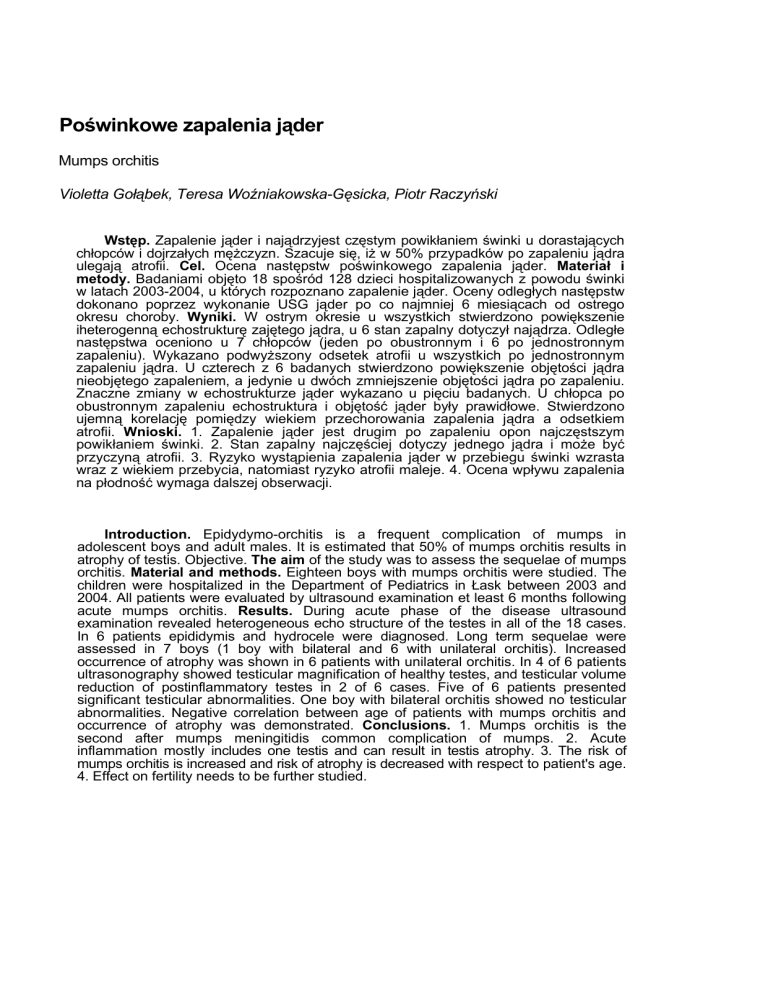
Poświnkowe zapalenia jąder
Mumps orchitis
Violetta Gołąbek, Teresa Woźniakowska-Gęsicka, Piotr Raczyński
Wstęp. Zapalenie jąder i najądrzyjest częstym powikłaniem świnki u dorastających
chłopców i dojrzałych mężczyzn. Szacuje się, iż w 50% przypadków po zapaleniu jądra
ulegają atrofii. Cel. Ocena następstw poświnkowego zapalenia jąder. Materiał i
metody. Badaniami objęto 18 spośród 128 dzieci hospitalizowanych z powodu świnki
w latach 2003-2004, u których rozpoznano zapalenie jąder. Oceny odległych następstw
dokonano poprzez wykonanie USG jąder po co najmniej 6 miesiącach od ostrego
okresu choroby. Wyniki. W ostrym okresie u wszystkich stwierdzono powiększenie
iheterogenną echostrukturę zajętego jądra, u 6 stan zapalny dotyczył najądrza. Odległe
następstwa oceniono u 7 chłopców (jeden po obustronnym i 6 po jednostronnym
zapaleniu). Wykazano podwyższony odsetek atrofii u wszystkich po jednostronnym
zapaleniu jądra. U czterech z 6 badanych stwierdzono powiększenie objętości jądra
nieobjętego zapaleniem, a jedynie u dwóch zmniejszenie objętości jądra po zapaleniu.
Znaczne zmiany w echostrukturze jąder wykazano u pięciu badanych. U chłopca po
obustronnym zapaleniu echostruktura i objętość jąder były prawidłowe. Stwierdzono
ujemną korelację pomiędzy wiekiem przechorowania zapalenia jądra a odsetkiem
atrofii. Wnioski. 1. Zapalenie jąder jest drugim po zapaleniu opon najczęstszym
powikłaniem świnki. 2. Stan zapalny najczęściej dotyczy jednego jądra i może być
przyczyną atrofii. 3. Ryzyko wystąpienia zapalenia jąder w przebiegu świnki wzrasta
wraz z wiekiem przebycia, natomiast ryzyko atrofii maleje. 4. Ocena wpływu zapalenia
na płodność wymaga dalszej obserwacji.
Introduction. Epidydymo-orchitis is a frequent complication of mumps in
adolescent boys and adult males. It is estimated that 50% of mumps orchitis results in
atrophy of testis. Objective. The aim of the study was to assess the sequelae of mumps
orchitis. Material and methods. Eighteen boys with mumps orchitis were studied. The
children were hospitalized in the Department of Pediatrics in Łask between 2003 and
2004. All patients were evaluated by ultrasound examination et least 6 months following
acute mumps orchitis. Results. During acute phase of the disease ultrasound
examination revealed heterogeneous echo structure of the testes in all of the 18 cases.
In 6 patients epididymis and hydrocele were diagnosed. Long term sequelae were
assessed in 7 boys (1 boy with bilateral and 6 with unilateral orchitis). Increased
occurrence of atrophy was shown in 6 patients with unilateral orchitis. In 4 of 6 patients
ultrasonography showed testicular magnification of healthy testes, and testicular volume
reduction of postinflammatory testes in 2 of 6 cases. Five of 6 patients presented
significant testicular abnormalities. One boy with bilateral orchitis showed no testicular
abnormalities. Negative correlation between age of patients with mumps orchitis and
occurrence of atrophy was demonstrated. Conclusions. 1. Mumps orchitis is the
second after mumps meningitidis common complication of mumps. 2. Acute
inflammation mostly includes one testis and can result in testis atrophy. 3. The risk of
mumps orchitis is increased and risk of atrophy is decreased with respect to patient's age.
4. Effect on fertility needs to be further studied.
